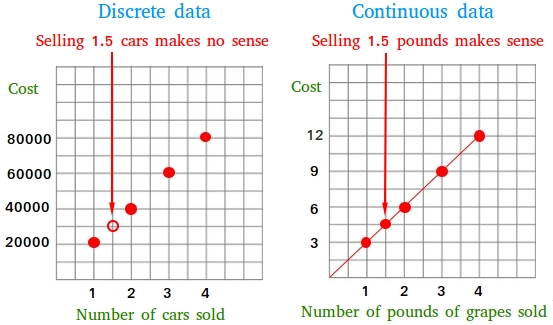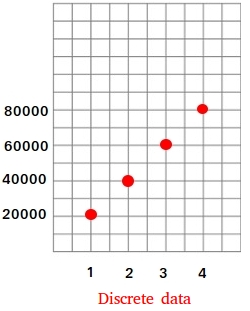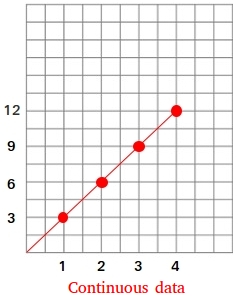Difference between discrete and continuous data
What is the difference between discrete and continuous data? Discrete data usually involve counting a number of items, such as the number of books, computers, people, and so forth. Continuous data are data where numbers between any two data values make sense.
The figure below may help you understand the difference between discrete and continuous data? If not keep reading!
For discrete data, numbers between two data values will make no sense. For example, suppose that the cost of producing a car is 20000 dollars. This situation will give discrete data only since you cannot produce half of a car, three-fourths of a car or two and a half car.

The table below shows the costs of producing 1, 2, 3, or 4 cars.
Number of cars Cost Point
1 20000 (1, 20000)
2 40000 (2, 40000)
3 60000 (3, 60000)
4 80000 (4, 80000)
If the company could produce 1.5 car, it will cost 30000. However, there is no such thing as 1.5 car. The figure below shows what the graph of a discrete data will look like for the table immediately above.
Notice that we cannot connect the points since the numbers between 1 and 2, 2 and 3, 3 and 4 do not exist.

On the other hand, a continuous data can have numbers between any two data values that make sense. Suppose the cost of grapes is 3 dollars per pound. The number of pounds you buy could be 1, 1.5, 2, 3, 3.5, 4, ...
Notice that 1.5 is a number between 1 and 2. By the same token, 3.5 is a number between 3 and 4. You do not have to buy exactly 1, 2, 3, 4, or 5 pounds, etc...
Here is what the graph of a continuous data will look like.

In the graph above, we show the points (1 3), (2, 6), (3, 9), and (4, 12). (3, 9) of course means that 3 pounds cost 9 dollars. Notice how any number of pounds could be chosen between 0 and 1, 1 and 2, 2 and 3, 3 and 4.